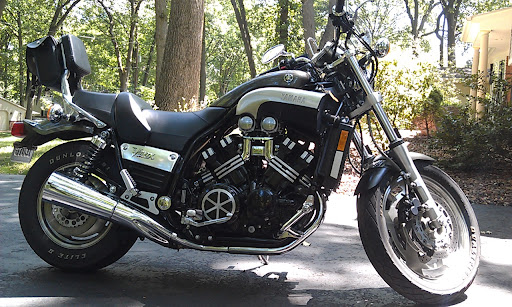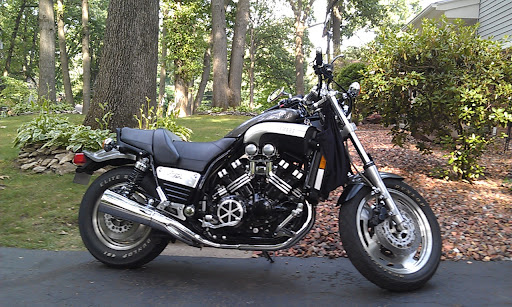RaWarrior once-again has given you good advice. Your idea of incremental, constant usage & practice riding is going to pay-off. His advice about the blind spot is always one to heed. It doesn't matter if it's in your car or on a bike-avoid the blind spot.
I was coming home last night on my bike, and was by Ft. Lauderdale International Airport on US-1 which is a divided highway w/3-4 lanes ea. way. A PT Cruiser to my left was behind slower traffic, so he decided to change into the lane to his right, which is where I was. Because it was dark, I hit my high beam to alert him to the presence of my bike already where he intended to go. He came into the lane anyway, and at this point, I was next to him. I moved to the right side of the lane, he kept coming. I hit my horn & sped-up as the lane in-front of us was clear. He kept coming. At that point, because I was accelerating and got ahead of him, I was able to avoid his inattention or outright bullying ("I have a car, I am bigger, out of my way!") and avoided further conflict/possible aggression.
These types of incidents happen every day. If you are on the road long-enough, they will occur multiple times a day, that's just how it is. People "don't see you," or don't care about taking the right of way and putting you in harm's way because they want to be where you are. You constantly have to scan around you. get in the habit of checking your mirrors, and take the 'long view' down the road. As has been said, do not focus on the car in-front of you, anticipate reactions of traffic approaching from the opposite direction, especially at intersections. If I am approaching an intersection, I may slow down to 1st gear to crawl-across an intersection because I see the driver trying to make a left turn may choose to do that right in-front of you. Those things happen all too-frequently. And, don't forget that the car behind you may be inattentive, and may expect you to maintain speed through an intersection, instead of slowing down. Sometimes as I approach an intersection, if there is traffic close behind me, I may tap my front or rear brake several times to alert the driver behind me that I am "braking," even if I am only doing it to activate my brake light, and not enough to slow-yet. Most people will slow themselves but a few will either tailgate you or try to pull-around you because you are slowing.
Sometimes in traffic, I slow-down (keeping an eye on traffic behind me) and then use my acceleration to pull ahead of the people following by a good amount, leading to a gap behind me. I usually do this when there is traffic behind me who may be following too-closely. This creates a gap in-which you can ride w/o having the guy behind you tailgating.
I also prefer to ride in gaps in traffic, and the above technique I call "gapping." You make your own gap. Be aware that people in lanes to the right or left of you may decide that the gap you just created is now theirs to take, so you always have to be alert for people comng into your 'zone,' the space around you on all sides. You need to develop the defensive posture that you are aware of any encroachments into your 'zone,' which expands as your speed increases. Again, constantly scan ahead of you, in your mirrors, and if you turn your head to the side either way, do NOT do it very long, the person you may have been following too-closely may have just hit the brakes! That is not the situation in which you find yourself as a new rider, because if you nail the brakes and try to avoid slamming-into the slowing vehicle in-front of you, the amount of traction your front wheel/tire has may just have been overloaded, and you could either 'highside' or 'lowside' (falling-off your bike, one is where you essentially fly over the handlebars ahead of the bike, the bike's front wheel usually 'tucks' under and you catapult over the bars; the other is where you fall to one side or the other, as-if you just were stationary, pulled-up your feet, and had the bike topple to one side or the other).
Keep practicing as you have been. The more saddle time and the more you can practice using both brakes, and w/increasingly-stronger actuations of your brakes, the better-off you will be when you need them for-real because of an inattentive driver or an aggressive one. Do your braking hard in a straight line at first, and gradually learn how to do the same thing while turning.
Remember, while turning, you usually have more room to lean, so if you find yourself moving to the outside of a curve and you think you may be headed off the outside or across the center line, roll-off the gas, and lean the bike some-more. This is where the practice countersteering will save your butt. Try to keep light pressure on the throttle and as you round the curve, this is where you gently want to apply gas to get drive off the corner.
Think of marginal traction on the road as change from a dollar, where available traction is =$1.00. If you are using $.70 worth of traction for turning, and suddenly need to use $.50 for braking while in a curve because a car just pulled out in-front of you from a side street (it happens all the time, anticipate it), you have just spent morre than your $1.00 and are headed for an accident, unless you modify one or the other to allow you to not exceed that $1.00.
Riding in the rain is another example of this except that rain (and traction in it) costs you part of that $, right off the bat. Instead of $1.00 of traction, rain costs, let's say $.30, so now you only have $.70 to spend on traction, divided between acceleration, braking, and turning. Don't short-change yourself!
Smoothness in operation is a good way to operate a motorcycle, jerky movements can unsettle the bike and rob $ out of your traction funds. Spend your money wisely, and invest in your future by practice as you have been.
To answer your question: yes, I usually put it into neutral just before coming to a stop. Then I 'cover' the clutch lever (fingers on the clutch lever, ready to pull it in) and watch to see that the traffic behind me is stopping. If they come-in behind me too-fast, I drop it into first gear in-preparation for squirting ahead or to the side to avoid the rear-end collision. I do not typically sit with the clutch pulled-in & the bike in gear at a light, waiting for it to change.
You should also 'cover' the front brake lever, especially crossing intersections. If your hands are big-enough and your levers are correctly sized and adjusted, you can use two fingers to do this, where you gently rest your index and middle fingers on-top of the front brake lever. You can also 'cover' the rear brake pedal so you get maximum braking effort when needed. Remember, your stopping distance using the rear brake only is two or more times what you can achieve using both front and rear brakes in-unison.




![JOYROOM Motorcycle Phone Mount, [1s Auto Lock][100mph Military Anti-Shake] Bike Phone Holder for Bicycle, [10s Quick Install] Handlebar Phone Mount, Compatible with iPhone, Samsung, All Cell Phone](https://m.media-amazon.com/images/I/5113ZNM8R8L._SL500_.jpg)

![Bike Phone Mount Holder, [Camera Friendly] Motorcycle Phone Mount for Electric Scooter, Mountain, Dirt Bike and Motorcycle - 360° Rotate Suitable for iPhone & Android Smartphones from 4.5-7.0 inches](https://m.media-amazon.com/images/I/51ZirRrsA+L._SL500_.jpg)








![Bovemanx Motorcycle Phone Mount Holder, [150mph Wind Anti-Shake][7.2inch Big Phone Friendly] Bike Phone Holder, Motorcycle Handlebar Cell Phone Clamp, Compatible with iPhone 16 Pro Max Smartphones](https://m.media-amazon.com/images/I/51F+1sontPL._SL500_.jpg)

![Lamicall Motorcycle Phone Mount Holder - [Dual Vibration Dampener] [720° Adjustment Arm] Motorcycle Cell Phone Holder, Bike Handlebar Phone Mount, for iPhone 16/15/ 14/13 Pro Max, 4.7-6.7" Phones](https://m.media-amazon.com/images/I/41g9IDInCIL._SL500_.jpg)




![Aomiker Motorcycle Phone Holder Mount - [Metal Extension Arm] [Dual Vibration Dampener] Motorcycle Cell Phone Mount, Bike Phone Handlebar Clamp for iPhone 16 15 14 13 Pro Max Plus, 4.7-6.7" Smartphone](https://m.media-amazon.com/images/I/51gU2g5VxgL._SL500_.jpg)






















